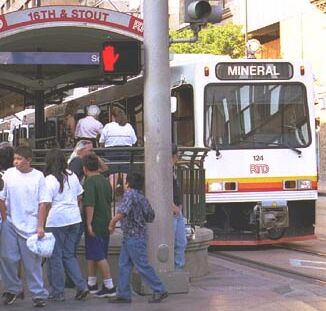
Light Rail Now/Light Rail Progress can be contacted at: Light Rail Now! |
If ever there was a slam-dunk case for the uniquely powerful effectiveness of rail transit – and light rail transit (LRT) – in building public transit passenger traffic, this has got to be it. Data compiled by the American Public Transportation Association reveal that, over the decade 1990-2000, total passenger-miles carried by US public transit increased at a very impressive pace – nearly 16%, or over 6.5 billion passenger-miles. (See table below.) And, of that growth, approximately 84% is accounted for by America's rail transit systems. Passenger-Mileage, Growth, and Percentage Growth
[Source: APTA, "Passenger Miles by Mode, Millions" (table), 2003]
All major modes of public transportation have reported more
riders. Particularly significant is the fact that public transportation
ridership has been rising at a faster rate than automobile use and
even domestic air travel. Furthermore, transit ridership growth appears to reflect greater public use of transit, and not simply more boardings due to more transfers. This is indicated by the substantial increase of approximately 16% in transit passenger-mileage from 1990 to 2000, shown in the table above – traffic which would not be increased merely by more transfers. As the table above reveals, total transit growth in the decade 1990-2000 amounted to more than 6.5 million passenger-miles (p-m). Of that, growth in the major rail transit modes totalled nearly 5.5 billion p-m – approximately 84% of the total (illustrated in the pie graph below, which provides the percentage breakdown in passenger miles for both major rail transit and motor bus, as well as all other modes).
The bar graph below compares the actual passenger-mileage growth for the major modes. Once again, while motor bus registered some increase, clearly, the major rail transit modes tallied traffic growth well in excess of motor bus. Rail growth outpaced motor bus growth by over 21 times, and LRT growth alone outpaced bus by more than three times.
Finally, the graph below illustrates the percentage rate of growth for the various major rail transit modes and motor bus.
Clearly, this final graph illustrates that, among the major transit modes, rail transit is the big winner, by a long shot, in generating the preponderance of transit passenger-miles. it also provides additional evidence of the enormous capability offered by LRT to expand mass transit ridership traffic in America's urban areas. Surely these data proclaim a clear-cut case for the tremendous potential of LRT and other rail transit modes in effectively addressing the mobility needs of American cities and significantly expanding the role of public transportation. Updated 2003/09/01 | |||||||||||||||||||||||||||||||||||